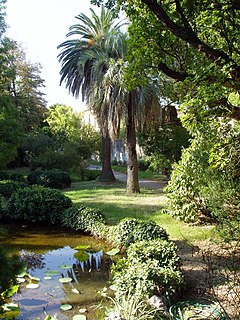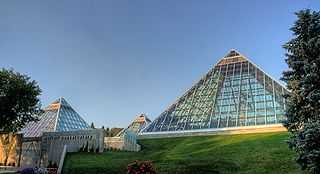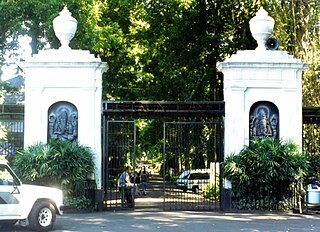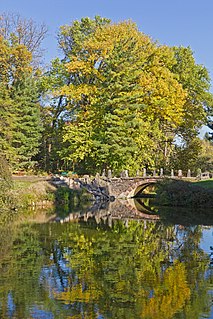
A botanical garden or botanic garden is a garden dedicated to the collection, cultivation, preservation and display of an especially wide range of plants, which are typically labelled with their botanical names. It may contain specialist plant collections such as cacti and other succulent plants, herb gardens, plants from particular parts of the world, and so on; there may be greenhouses, shadehouses, again with special collections such as tropical plants, alpine plants, or other exotic plants. Most are at least partly open to the public, and may offer guided tours, educational displays, art exhibitions, book rooms, open-air theatrical and musical performances, and other entertainment.

The Missouri Botanical Garden is a botanical garden located at 4344 Shaw Boulevard in St. Louis, Missouri. It is also known informally as Shaw's Garden for founder and philanthropist Henry Shaw. Its herbarium, with more than 6.6 million specimens, is the second largest in North America, behind that of the New York Botanical Garden. The Index Herbariorum code assigned to the herbarium is MO and it is used when citing housed specimens.

The New York Botanical Garden (NYBG) is a botanical garden at Bronx Park in the Bronx, New York City. Established in 1891, it is located on a 250-acre (100 ha) site that contains a landscape with over one million living plants; the Enid A. Haupt Conservatory, a greenhouse containing several habitats; and the LuEsther T. Mertz Library, which contains one of the world's largest collections of botany-related texts. As of 2016, over a million people visit the New York Botanical Garden annually.

The United States Botanic Garden (USBG) is a botanical garden on the grounds of the United States Capitol in Washington, D.C., near Garfield Circle.

A conservatory is a building or room having glass or other transparent roofing and walls used as a greenhouse or a sunroom. Usually it refers to a space attached to a conventional building such as a house, especially in the United Kingdom. Elsewhere, especially in America, it can often refer to a large free-standing glass-walled building in a botanic garden or park, sometimes also called a palm house if tall enough for trees. Municipal conservatories became popular in the early 19th century.

The Atlanta Botanical Garden is a 30 acres (12 ha) botanical garden located adjacent to Piedmont Park in Midtown Atlanta, Georgia, United States. Incorporated in 1976, the garden's mission is to "develop and maintain plant collections for the purposes of display, education, conservation, research and enjoyment."

The Arnold Arboretum of Harvard University is a botanical research institution and free public park, located in the Jamaica Plain and Roslindale neighborhoods of Boston, Massachusetts. Established in 1872, it is the oldest public arboretum in North America. The landscape was designed by Charles Sprague Sargent and Frederick Law Olmsted and is the second largest "link" in the Emerald Necklace. The Arnold Arboretum's collection of temperate trees, shrubs, and vines has a particular emphasis on the plants of the eastern United States and eastern Asia, where arboretum staff and colleagues are actively sourcing new material on plant collecting expeditions. The arboretum supports research in its landscape and in its Weld Hill Research Building.

Fairchild Tropical Botanic Garden is an 83-acre (34 ha) botanic garden with extensive collections of rare tropical plants including palms, cycads, flowering trees, and vines. It is located in the city of Coral Gables, Miami-Dade County, Florida, United States, just south of Miami, surrounded at the north and west by Matheson Hammock Park.
The Buffalo and Erie County Botanical Gardens are botanical gardens located within South Park in Buffalo, New York, United States. These gardens are the product of landscaping architect Frederick Law Olmsted, glass-house architects Lord & Burnham, and botanist and plant-explorer John F. Cowell.

The Adelaide Botanic Garden is a 51-hectare (130-acre) public garden at the north-east corner of the Adelaide city centre, in the Adelaide Park Lands. It encompasses a fenced garden on North Terrace and behind it the Botanic Park. Work was begun on the site in 1855, with its official opening to the public on 4 October 1857.

Phipps Conservatory and Botanical Gardens is a botanical garden set in Schenley Park, Pittsburgh, Pennsylvania, United States. It is a City of Pittsburgh historic landmark and is listed on the National Register of Historic Places.

The Muttart Conservatory is a botanical garden located in the North Saskatchewan river valley, across from the downtown core in Edmonton, Alberta, Canada. One of the best-known landmarks of Edmonton, the conservatory consists of three city-operated greenhouses, public gardens, as well as four feature pyramids for display of plant species found across three biomes, with the fourth pyramid hosting a seasonal display. A fifth minor skylight pyramid lights up the central foyer.

The Bogor Botanical Gardens is a botanical garden located in Bogor, Indonesia, 60 km south of central Jakarta. It is currently operated by Indonesian Institute of Sciences. The Garden is located in the city center and adjoin the presidential palace compound of Istana Bogor. It covers an area of 87 hectares and contains 13,983 different kinds of trees and plants of various origin. The geographic position of Bogor means it rains almost daily, even in the dry season. This makes the Garden an advantageous location for the cultivation of tropical plants.

Palm house is a term sometimes used for large and high heated display greenhouses that specialise in growing palms and other tropical and subtropical plants. In Victorian Britain, several ornate glass and iron palm houses were built in botanical gardens and parks, using cast iron architecture. Especially in English-speaking countries outside the British Isles, these are often called conservatories, in the UK mainly a term for small glass structures attached to houses.

The Berlin Botanic Garden and Botanical Museum is a botanical garden in the German capital city of Berlin, with an area of 43 hectares and around 22,000 different plant species. It was constructed between 1897 and 1910, under the guidance of architect Adolf Engler, in order to present exotic plants returned from German colonies.

The San Antonio Botanical Garden is a 33-acre (130,000 m2), non-profit botanical garden in San Antonio, Texas, United States, and the city's official botanical garden.

The Conservatoire botanique national de Brest is a notable botanical garden located at 52 Allée du Bot, Brest, Finistère, in the region of Brittany, France. It is open daily without charge.

Kew Gardens is a botanic garden in southwest London that houses the "largest and most diverse botanical and mycological collections in the world". Founded in 1840, from the exotic garden at Kew Park, its living collections includes some of the 27,000 taxa curated by Royal Botanic Gardens, Kew, while the herbarium, one of the largest in the world, has over 8.5 million preserved plant and fungal specimens. The library contains more than 750,000 volumes, and the illustrations collection contains more than 175,000 prints and drawings of plants. It is one of London's top tourist attractions and is a World Heritage Site.

The Bali Botanic Garden is the largest botanic garden in Indonesia and is located in the mountainous region of Bedugul, Tabanan Regency, central Bali, around 90 minutes drive north of Denpasar. The Garden was established on 15 July 1959 and is situated around 1300 metres above sea level overlooking Bratan Lake and the Ulun Danu Temple on the slopes of Tapak Hill. The Garden is a centre for botanical research, conservation, education and recreation. It is operated by the Indonesian Institute of Sciences (LIPI).

The Conservatory and Botanical Garden of the city of Geneva is a museum and an institution of the City of Geneva.




















